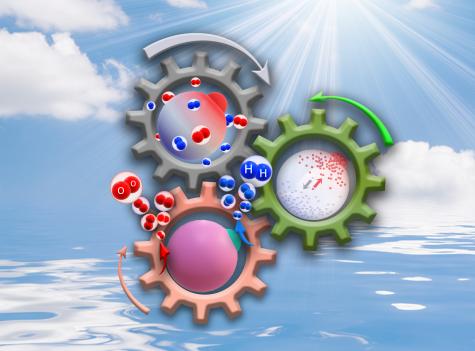Understanding Water Splitting, and Making It Better

Sunlight-driven water splitting is a promising way to generate hydrogen, as an important fuel or chemical feedstock, but has so far it's proven to be too inefficient or costly for practical use. Researchers led by Shu Hu, assistant professor of chemical & environmental engineering, set out to better understand water splitting processes with certain photocatalyst particles - and from there, develop more efficient systems. Their results were recently published in Energy & Environmental Science.
 Solar-induced water-splitting involves multiple processes, including light absorption, generation of electron-hole pairs, charge separation, and charge transfer. To develop the technology for efficient commercial applications, researchers need to fully understand each one of these processes, and their relation to the others. Hu and his lab did side-by-side study of charge separation - in which a negatively charged electron and its positively charged electron hole are separated - and charge transfer, in which part of an electron charge transfers across photocatalyst/water interfaces. These two processes make up the “energetics” and “kinetics” of photocatalytic water splitting. And as Hu and his research team found, they are closely interlocked - the kinetics affect the energetics, and vice-versa.
Solar-induced water-splitting involves multiple processes, including light absorption, generation of electron-hole pairs, charge separation, and charge transfer. To develop the technology for efficient commercial applications, researchers need to fully understand each one of these processes, and their relation to the others. Hu and his lab did side-by-side study of charge separation - in which a negatively charged electron and its positively charged electron hole are separated - and charge transfer, in which part of an electron charge transfers across photocatalyst/water interfaces. These two processes make up the “energetics” and “kinetics” of photocatalytic water splitting. And as Hu and his research team found, they are closely interlocked - the kinetics affect the energetics, and vice-versa.
“It’s as if all of these gears are locked and interdependent,” Hu said. “You have to start with a good catalyst, but you also have to co-optimize the interface - the co-catalyst and the photocatalyst, those two things work together. That’s important to driving up efficiency.”
Understanding why photocatalytic water-splitting is inefficient is tricky. It’s an extremely complicated system, and there’s been very little investigation of the processes involved across multiple length scales. Instead, much research has tended to rely on trial and error.
“A lot of people are trying different things to see whatever works, without really knowing what’s going on inside a suspension of particles,” said Rito Yanagi, a Ph.D. student in Hu’s lab and a co-lead author of the study. “So we studied in detail the mechanisms of the kinetics and the energetics.”
Getting a better sense of how these processes work is a crucial step to developing an efficient system, Hu said. Also crucial is making sure that the system is designed with an awareness of the interdependent nature of the kinetics and energetics.
“The next step is to address the efficiency gap,” he said. “We have this very good model and we need to further apply this model to new materials systems.”
For instance, he said, they’re working with a range of photovoltaic materials, which have been made into solar panels but not into particles. “We’re leveraging those legacy, high-efficiency materials so that we have many scalable ways of manufacturing particles, and using our model to design the most efficient one.”

